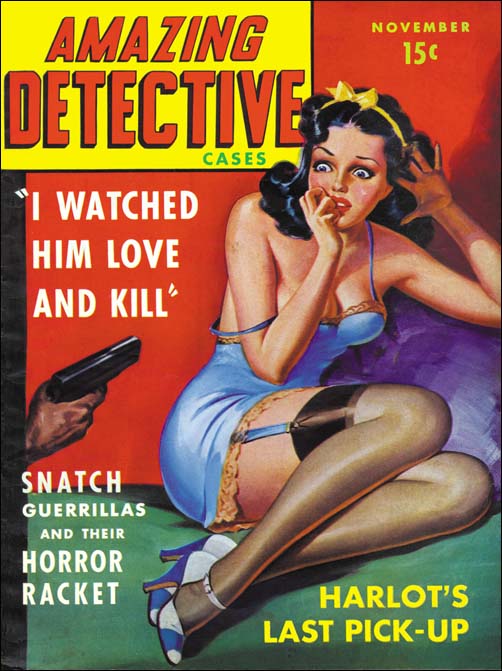
Amazing Detective Cases vol. 1 no. 7 (November 1941) unidentified artist
Joe Simon was working as a freelance editor for Fox Comics for only a three month period before he left to take a position with Timely, still on a freelance basis. Some scholars have described Joe’s job at Timely as a General Editor but in his recent interview (Jim Amash, Alter Ego #76) Joe described it as Art Editor. Those that prefer to call Joe a General Editor usually give the Art Editor title to Jack Kirby. As far as I can tell the allocation of titles has been solely based on the testimony of either Joe Simon or Jack Kirby. Personally I suspect that at the time job titles held no real significance for Martin Goodman the only thing that mattered was the work to be done.
The work that generally holds the interest for most was for the comic books. Unfortunately none of the comics provide credits for the editorial personnel. Kirby did most of the drawing during the Timely period but Joe did some as well either alone or with Jack. But who did the drawing is not the issue here. One interesting suggestion comes from the splash to a Captain Daring story from Daring Mystery #7 (April 1941). The drawing for the story was all by Jack except for the figure of Captain Daring in the splash. That substitution is not what would be expected if Jack was the Art Editor. Otherwise I have not seen any evidence to help in this question about editorial attributions. This record stands in sharp contrast to Simon and Kirby’s post-war collaboration where a good number of examples of Kirby altering another artist’s work have been found along with some by Simon as well.
Comic books were not the only publications produced by Timely at this time. Pulps still played an important part of the company’s income. However so far I have found no help from the pulps about editorial functions either. Kirby does provide much of the art used to illustrate pulp stories but Simon and other artists show up as well. No editorial credits are provided. Joe has said (Alter Ego #76 interview) that he was not an editor for the pulps, he only put them together.
Although the artistic contributions to Timely’s comic books and pulps has been well known for some time, another of the publisher’s products, magazines, has generally been overlooked. Fortunately Kirby scholar and sleuth Tom Morehouse has been actively investigating Timely magazines. A number of magazine illustrations by Jack Kirby that Morehouse uncovered were included in the back of Greg Theakston’s “The Comic Strip Jack Kirby” Recently Tom has kindly loaned me some copies of Timely magazines with examples by other artists. Simon has described these magazines as “flats” which are “glossy magazines without the gloss”.
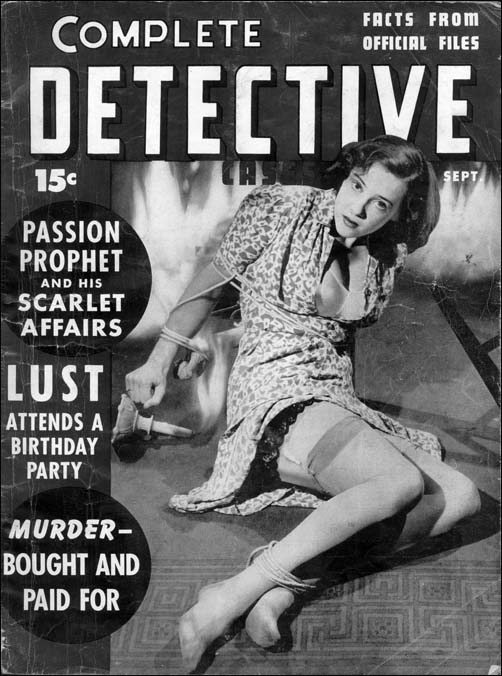
Complete Detective Cases vol. 3 no. 5 (September 1941)
The Timely periodicals under consideration are all detective magazines; Amazing Detective Cases, Complete Detective Cases and National Detective Cases. Amazing Detectives Case is listed as being published by Crime Files Inc. while Complete Detective Cases and National Detective Cases are said to be by Postal Publications Inc. However this is nothing more then the use of multiple company names by publishers of that day. It is not clear why Timely and other publishers did this but since it was such a common practice there must have been some benefit. These detective magazines are filled with supposedly true stories about various criminals. Stories of murder and other lurid crimes predominate throughout. A look at the covers reveals another important aspect of the magazines appeal. The five covers I borrowed all show images (four using photographs and one a painting) of a woman, generally bound. The recurring characteristic of these covers seems to be the showing of as much legs and cleavage as possible. Frequently words like sex and lust are prominently displayed on the cover. At the time these magazines would not have been considered respectable, but where they thought to be pornographic? I do not know about 1941, but in January 1958 issues of Complete Detective Cases and Amazing Detective Cases were list as prohibited on the grounds of that they were indecent or obscene as covered by the Censorship of Publications Act.
As with the pulps, most of the art used in the detective magazines was by Jack Kirby with other artists providing less numerous contributions. What is of particular interest is that the contents pages of all the magazines examined so far consistently list Joe Simon as the Art Director. (In his Alter Ego #76 interview Joe says the editor was named Levi but the content pages list him as Robert E. Levee. But who knows perhaps, as was so common in those days, the editor was trying to use a name that was less obviously Jewish.) The dates of the magazines known to include Simon credits as Art Director range from November 1940 through July 1941. As not all of the Timely detective magazines have been examined and Joe’s employment at Timely covered a greater period, further Timely detective magazines listing Simon as Art Director will undoubtedly be found.
The Timely detective magazines included extensive use of black and white photographs throughout the interior. This meant that better printing presses were used then those for the interiors of either comic books or pulps. Art generated for the magazines did not have to be the inked pencils used for comics nor the stipple boards frequently used for pulp illustrations. Instead the art was generally ink washes but some may have been done with an air brush. Pretty much any technique that an artist might desire to use could be accommodated except the use of color. Some of the photographs appear to have been retouched with an air brush. Sometimes this was done to improve an inferior photograph. The photographs looked like they were obtained from a variety of sources both professional (police files) and amateur. In other cases an air brush was used to add features that were not originally in the photo. For example firing blasts from gun barrels or flames of a fire (see the Complete Detective vol. 3 no. 5 cover shown above). I do not know whether Simon did the various photograph alterations himself but he certainly was capable of it. Joe’s previous years as a newspaper staff artist included a lot of photograph retouching with an air brush.
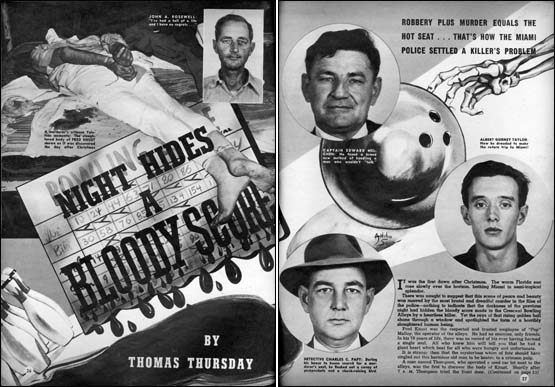
Complete Detective Cases vol. 3 no. 5 (September 1941) “Night Hides a Bloody Score” Artilio Sinegra (signed)
As Art Director, Joe Simon was also involved with the layouts used in the magazines. In his previous job as a newspaper staff artist, Simon had very likely been called to do paste-ups. However I doubt that the work he did for the newspapers had the unusual layouts found in these Timely detective magazines. In the magazines photographs were combined in unusual manners and art work would sometimes be mixed in. The first two pages for “Night Hides a Bloody Score” shown above is a good example. The art was signed by Artilio Sinegra, an artist I have not found any information on. I doubt that Sinegra had anything to do with the design of the spread. In this example circular photos were included on the right page so as to correspond to the form of the bowling ball. The legs of the dead man on the left page first underlie then intrude over the title. The body on the left forms a diagonal that is counter balanced by that formed by the skeletal arm, bowling ball, title and pins. This emphasis on design is characteristic of some of the comic book work particularly the double page splashes from Captain America. (See the chapters about Captain America #6, #7, #8, #9, and #10 of my serial post the Wide Angle Scream) Such designs are present throughout the detective magazines I have seen, even when other artists were used or in layouts consisting solely of photographs. I conclude that whether or not he did the actual paste-ups, Joe Simon was responsible for the designs. Only one of the magazines that Tom loaned to me was from early during Joe’s time as Art Director but it does suggest that perhaps Joe started out with simpler designs and progressively got more inventive. These Timely magazines may provide the means of showing Joe acquiring his skills at layout that he would use throughout the rest of his career.
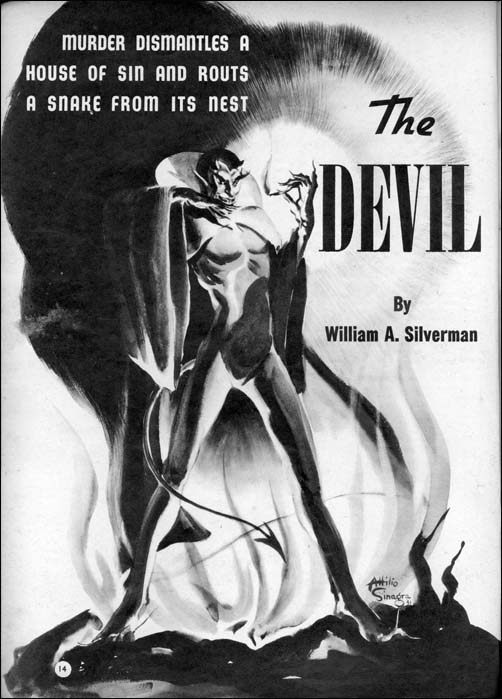
Complete Detective Cases vol. 3 no. 5 (September 1941) “The Devil Strikes a Match” Artilio Sinegra (signed)
Photographs were the primary sources used for the introduction to a story and illustrations generally played a more minor roll. However in some cases the introduction was only artwork. “The Devil Strikes a Match” has an ink wash by Artilio Sinegra. Since I have never come across his name as a comic book artist, perhaps he only did illustrations. The two signed works by Sinegra that I have provided above are the only ones that I can safely attribute to him.

Complete Detective Cases vol. 3 no. 2 (March 1941) “The Mask Man of the Middle West”, art by Al Avison
Tom Morehouse has provided me with information for 15 Timely detective magazines. In this group there are a total of 30 illustrations that are either signed or can be attributed with reasonable certainty. There are a number of incidental graphic additions that just are not sufficient to even provide a guess as to the creator. The majority (19) of the illustrations were done by Jack Kirby. The next most prolific artist was Al Avison who I credit with 5 certain and 2 possible illustrations. The example I provide above is perhaps the best one. I like Avison’s work but his early stuff tended to be a little crude and his talent only really blossomed after Simon and Kirby left Timely. In this case he has created a great composition. The low angle provides an interesting view and I am sure Martin Goodman appreciated the lengthy legs as well. A similar importance placed on attractive legs can be found in another Al Avison illustration (“I Watched Him Love and Kill”, v. 1 no. 7, November 1941).
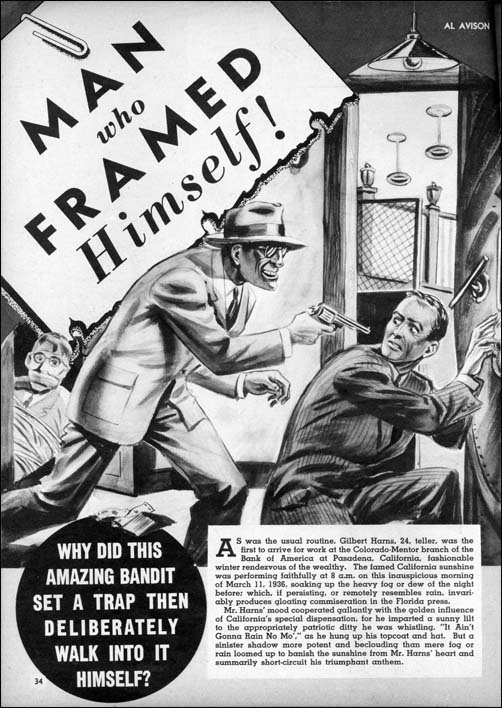
Amazing Detective Cases vol. 1 no. 7 (November 1941) “Man Who Framed Himself”, art by Al Avison (signed)
Unfortunately the rest of his illustration work was not nearly so well done. I thought I should include at least one other Avison illustration to give a more balanced view of his work in the Timely detective magazines. Even though it shares the same theme of an armed safe robbery it is not anywhere nearly as interesting as “The Mask Man of the Middle West”.

Complete Detective Cases vol. 3 no. 6 (November 1941) “Detroit’s Zombi”, art by Al Avison?
The art with the unusual witch-like creature for “Detroit’s Zombi” is unsigned. I cannot say precisely why, but it looks like Avison’s work to me. There is some similarity to the crude bat with one on a cover that Al did for Speed Comics #15 (November 1941) but both are nothing more then primitive silhouettes so I would not want to make too much of that similarity. The witch has a striking resemblance to the one of the Simon and Kirby wide splash for Captain America #8 (November 1941). The Kirby touch is clear in the Cap splash but he certainly did not draw the illustration for “Detroit’s Zombi”. However I am sure Kirby’s witch was the model that, shall we say, inspired Avison’s version. Incidentally the image of the young girl is one of those retouched photographs I mentioned before. In this case the photo has been so heavily work on with an air brush that it now blurs the distinction between photography and painting.

Complete Detective Cases vol. 3 no. 2 (March 1941) “Cop Killer on the Loose”, art by Joe Simon (signed)
Among the 30 illustrations that have so far been inventoried there are two by Joe Simon. Joe had experience at doing ink wash illustrations during his time as a newspaper staff artist. His brush work is truly confident as he combines detailed work (such as in the figures) with more sketchy rendition (particularly the background walls). The way Joe handles round stones in the wall is very reminiscent of some of his comic book work, for instance the cover for Weird Comics #3 (June 1940) or the Fiery Mask story “The Strange Case of the Bloodless Corpses” (Human Torch #2(1) Fall, 1940). Both Joe and Jack showed in these magazine illustrations a willingness to use bold brush strokes that is prescient for the work that they would do after the war.
I would like to extend my thanks to scholar Tom Morehouse for sharing these Timely detective magazines with me and allowing me to use them in this blog.


Harry,
The thing I love about these Timely detective magazines (there were 3 titles, Amazing, Complete & National Detective Cases) is that they give us a chance to examine early uses of layout designs which S&K would utilize many times in the future. As Joe’s tenure as Art Director wore on he began to take many of these ideas and transfer them to the pages of the comics they were producing. I’ve included the title pages from three issues, all of which were on the stands either before or concurrently with Captain America #1, the last of which has an early use of S&K’s lack of border restraint and anyone even remotely familiar with Simon & Kirby’s comic work should recognize the design elements used in the single and double page photo & art layouts. BTW, although the early covers were primarily photos the later issues began to use painted covers, a number of which have been attributed to the noted pulp artist Norman Saunders. I’ve yet to come across a similar Love Confessions magazine with Joe as Art Director but I’ll keep on looking.
Tom